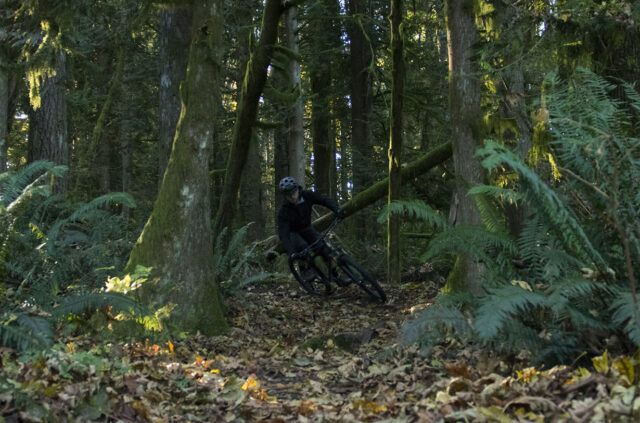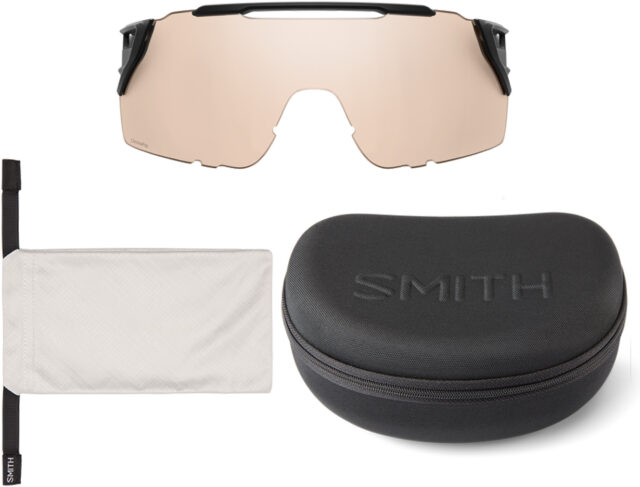Smith Forefront 2 Helmet
Size Tested: Large
MSRP: $240
Blister’s Measured Weight: 409 g / 14.4 oz
Smith Attack MAG MTB Glasses
Lenses tested:
- Photochromic Clear to Gray
- ChromaPop Low Light Amber
MSRP: $259
Blister’s Measured Weight: 34 g / 1.2 oz
Test Location: Washington
Test Duration: 3 months

Intro
The original Smith Forefront helmet came out in 2014 and raised some eyebrows due to its unconventional looks and novel material use. Instead of relying primarily on expanded polystyrene (EPS) foam for padding, which is essentially the “standard” material used in most bike and ski helmets, the Forefront featured a substantial amount of Koroyd, which basically looks like a whole lot of drinking-straw segments glued together to make a honeycomb structure.
I was a big fan of the original Forefront, due to how well it fit, its low weight, and its broader-than-average (especially when it was first released) coverage.

Smith recently updated the helmet and the Forefront 2 maintains many of the same design features, but with some noteworthy updates. I’ve been testing the new model and have also been using it with the Smith Attack MAG MTB glasses, which integrate neatly with the Forefront 2, which is why we’re reviewing the pair together.
Forefront 2 Helmet
The Forefront 2 carries a great deal of its design over from the original Forefront, but with some welcome refinements.
First and foremost, there’s the extensive use of Koroyd throughout the shell; the Forefront and Forefront 2 still use EPS foam around the perimeter of the helmet, but the vast majority of the helmet is constructed of Koroyd.
Smith says that Koroyd absorbs energy more effectively than EPS, while also weighing less and offering more airflow. While the hollow Koroyd tubes do certainly mean that a lot of the helmet shell is technically open to airflow, those tubes are a bit too small to allow for truly free airflow. Some people noted that the original Forefront wasn’t the most ventilated helmet, since most of the vents had a layer of Koroyd underneath them, which reduced their effectiveness. The Forefront 2 adds two large, fully open vents at the front and back of the helmet, and the increase in ventilation is noticeable. It’s probably still not the most free-flowing helmet out there, but I’ve used the Forefront 2 on days when temperatures were over 90° F (32° C) and haven’t found it particularly lacking in terms of breathability / ventilation.
The Forefront 2 is available in three sizes and eight colors, ranging from subdued to extremely loud — there’s something for everyone here. Our test helmet came in “Matte Gravy,” and my main thought on that is that I sincerely hope that whatever gravy you, dear reader, may be consuming is not this color: it’s essentially a two-tone charcoal colorway, with subtle copper accents. As a color for gravy, it would be revolting, but I think it’s a sharp-looking helmet.
The Forefront 2 carries over the excellent dial retention system (Smith calls it VaporFit) from the original, which offers a wide range of adjustment and does a very good job of fitting snugly and securely without creating any pressure points. In addition to the dial itself, the forward connection points of the VaporFit band (which fall approximately above the temple) can be set to four different positions to adjust the overall adjustment range, and the rear-center anchor can be set to three different heights to adjust the angle of the band. The fit of the original Forefront was excellent on my head, and the Forefront 2 feels nearly identical — it’s one of the most comfortable and secure helmets I’ve used.
Of course, that doesn’t necessarily mean it’ll work for your head. We’d always recommend trying on helmets before you buy, but if you’re familiar and happy with the original Forefront, I’d expect the fit of the Forefront 2 to work well, too.
The Forefront 2’s visor is substantially longer than that on the original, and the detents between the visor’s three positions are considerably firmer. I’d often accidentally bump the visor on the original Forefront and it’d move from my desired position. It’s still happened a few times on the Forefront 2, but has been far less frequent.
The Forefront 2 features a MIPS liner, as has become common for higher-end helmets in recent years. For those not familiar, MIPS stands for Multi-directional Impact Protection System and is essentially a plastic liner that sits between the helmet shell and your head. It allows the helmet to rotate slightly, with the idea that this helps reduce the likelihood of brain injuries in a crash, particularly pertaining to impacts that hit the helmet at an angle. The original Forefront was available both with and without MIPS, but I’ve only ever used the non-MIPS version (the Forefront 2 is only available with MIPS).
On other MIPS helmets, I’ve found the sensation of the helmet rotating to be a bit annoying, and in some cases, it’s made a fair bit of noise as well. The Forefront 2 is perhaps the best MIPS helmet I’ve used in this regard; the Forefront 2 still moves a bit (which is precisely the point of MIPS) but the motion is damped / controlled just enough to not feel floppy, and I haven’t noticed much noise from it on the trail.

Like the original Forefront, the Forefront 2 features an optional GoPro / light mount that attaches with a screw to a threaded insert in the top of the helmet. I’ve used it for mounting a Light and Motion Seca, which uses a GoPro mount, and it works well and securely holds the light. With the added weight of a light on top of the helmet, though, the movement of the MIPS system became much more pronounced and I’ve preferred to use the old, non-MIPS Forefront for night-riding duty.
Lastly, the Forefront 2 is designed to integrate with many of Smith’s “Performance” eyewear models, with what Smith calls “front and rear eyewear storage channels.” Below I’ll go into how those work on the trail in more detail, but in short, the Attack MAG MTB and a number of Smith’s other glasses can clip into the helmet at both the front and back for convenient carrying when you don’t want to be wearing them.
Attack MAG MTB Glasses
The Attack MAG MTB is one of two glasses that Smith says is specifically designed with mountain biking (rather than road) in mind, and unlike the mtb-oriented Smith Wildcat, the Attack MAG MTB features a really nice, interchangeable lens-swap design.
Smith calls the Attack MAG MTB a “medium fit, large coverage” pair of glasses, and I’ve been testing them with the “Photochromic Clear to Gray” lens as well as the “Low Light Amber” option.
Smith offers the Attack MAG MTB with a range of lens tints, ranging from a stated 10% to 80% visible light transmission values (aka, “VLT”). All versions come with two lenses, as well as a hard carrying case that stores the glasses and both lenses, plus a soft bag for the glasses.

The lens swap on the Attack MAG MTB is incredibly slick. The “frame” of the glasses really comprises two separate temple pieces, with the lens itself connecting the two — pretty standard for interchangeable-lens glasses in this category. The two temple pieces clip to the lens with a magnetic clasp (hence the “MAG” in the name); to remove the frame, simply put your thumb over the hinge in the frame and bend the frame inward, as if you were folding the glasses for storage. The clasp pops open, and the temple pieces slide off. To reattach, simply line up the frame and lens and push forward to pop the two together. It’s a simple, sturdy system that’s incredibly quick and easy.
Unfortunately, the nosepiece also needs to be swapped between lenses, and that’s attached with more standard clips at the bottom of the lens. Swapping it isn’t hard or time consuming, but compared to the magnetic clasps on the side frames — which could probably be sold as a fidget toy because of how simple they are — it feels a bit clunky. The nosepiece is adjustable, with two positions (high and low; slide each side of the rubber nosepiece up and down to toggle) which help fine tune the fit.

My head is probably a little bigger than average, but not huge — I tend to wear Large helmets from most brands. Smith’s description of the fit of the Attack MAG MTB seems pretty accurate; its coverage is large, but it’s by no means a huge fit. The lens sits very close to the face, for good and bad (more on that in a bit) and the glasses have done a great job of staying put on my face, without being overly tight or otherwise uncomfortable.
The “Photochromic Gray to Clear” lens that I’ve been using reportedly changes from 20% to 85% VLT, according to Smith, and across the spectrum, its tint seems quite light. Even in direct sunlight, the lens never becomes super dark; people riding out in the open in a lot of bright sunlight will probably want one of the darker lens options. At its lightest, this photochromic lens feels truly clear, despite Smith stating only 80% maximum VLT.
The lens’s transition from dark to light is certainly not instantaneous; if you’re repeatedly darting into direct sun and then back into the woods, the photochromic lens will struggle to keep up. It works best when encountering changing light conditions over the course of a ride, such as climbing up a fire road with some more exposure and then descending in the woods, where the transitions aren’t happening in rapid-fire fashion. This is typical of photochromic lenses in our experience — the Attack MAG MTB isn’t notably slower than most. I’ve also found the lens to stay a bit darker than I’d like in some “dappled light” situations, notably under very heavy tree cover on a bright day, when conditions are essentially dark and shaded, but little beams of bright light still manage to poke through. (And if you don’t want a photochromic lens, the Attack MAG MTB is available with many different versions of Smith’s non-changing, high-contrast ChromaPop lenses.)

The Low Light Amber lens that comes with the photochromic one is exactly as advertised — a very lightly tinted amber lens, with 65% stated VLT. It’s very good in low-light situations, and unless conditions were fairly bright (by PNW standards) or super dark, I found it worked well under tree cover. In open skies and bright light, something darker would certainly be preferable.
The optics of the Attack MAG MTB’s lenses are excellent. Both lenses are crisp, with no noticeable distortion and very little glare or bright spots in most light conditions. They’re secure on my face without being tight or uncomfortable, and offer very good coverage with a close-to-the-face fit that does a good job of keeping out debris. When sweating really heavily, however, I have had some issues with beads of sweat catching on the upper frame and running down onto the lens, since there’s such a small gap between my brow and the frame.
The Attack MAG MTB has also done a relatively good job of resisting fogging on some cooler, very wet rides. But in general, I’ve found goggles to be a better solution than glasses when conditions are very wet, and the Attack MAG MTB is no exception there. Having a foam gasket against your face goes a long way in terms of keeping moisture off the lenses, and the greater separation between your face and the lens tends to do better when it comes to fogging.
Helmet / Glasses Integration
One of the more interesting features of the Forefront 2 / Attack MAG MTB combo is the grooves on the helmet shell that Smith included to carry the glasses. The temple pieces fit neatly into a groove that runs around the circumference of the helmet, allowing them to be stowed either on the front of the helmet (under the visor) or at the back (facing rearward). It’s a feature that I’ve regularly used and come to really appreciate.
Often, when climbing, I’ll take off the glasses and stow them on the helmet to get them off my face for more airflow, and to stop myself from dripping sweat all over them and clouding the lenses. Having a neat and easy place to put them for this purpose is super convenient, and quite welcome.
There are a few limitations to the system, however. First, while it’s quite secure — especially in the front position, where the visor helps hold the glasses in place a bit — it’s not quite secure enough to hold them on when descending a rough trail at speed. Climbing uphill and riding more mellow, rolling terrain posed no problems, but the system has its limits. Second, the forward position also only really works when the visor is in its highest position — with the visor lowered, the glasses hang down into your field of view.
The combination of the photochromic lens I tested and the rear stowing position exposed an interesting quirk: on the back of the helmet, exposed to more light, I found the lens tinting to a far darker setting than it would if it were on my face. Since the lens transitions take a minute or so to fully complete, this meant that I found myself putting on the glasses at the top of a climb, only to have to wait briefly for the lens to lighten back up before I dropped into the trail. As such, I found myself preferring the forward stowing position (under the visor), especially when using the photochromic lens.
Bottom Line
The Forefront 2 is an excellent helmet with a top-notch fit-adjustment system and notably improved ventilation from the original. It’s a great choice for a half-shell Trail / Enduro mountain bike helmet, especially for riders interested in taking advantage of the integration with many of Smith’s “Performance” glasses, including the Attack MAG MTB — which offers excellent optics and clarity, a wide range of lens options, and a broad-coverage fit.
Both are undeniably expensive, and many folks will be better off saving some money on less expensive alternatives (like Smith’s very good Session or Rover helmets). But the Forefront 2, in particular, stands out for being an especially well refined and fairly lightweight helmet that — at least on my head — is truly one of the most comfortable and best fitting options that I’ve tried to date.
The price tag of the Attack MAG MTB is frankly a little harder for me to justify. The optics are excellent, you get two high-quality lenses for the price, the lens-swap system is slick and easy to use, and the helmet integration is a nice touch (a number of Smith’s less-expensive models work in that regard, too). But the refinements over many more modestly priced options aren’t going to make this particular pair of glasses worth it for many folks. If, however, you want two high-end lenses and like to swap lenses frequently, that’s where the Attack MAG MTB starts to make more sense.


Great review, thanks! I own the Forefront 2 and I have some nitpicks. Number one, the helmet sits too close and low behind the ear which blocks the ends of my Roka sunglasses’ arms. It’s surprisingly awkward and frustrating to put my sunglasses on and to have to sit their finicking to get everything to lay flat. In my opinion, that extra helmet coverage is not necessary. I don’t have this problem at all with my Smith road helmet. This would be less of an issue with sunglasses that curve down behind the ear rather than extend straight and grip the side of the head like mine. Also, I wish the helmet had more open room just above the vaporfit dial so you could grasp the dial from any angle. As it is, you can only grab the bottom half of the dial so it’s that much harder to turn. I find myself needing to adjust the dial somewhat often (looser on the uphill, a bit tighter for the down). Lastly, Smith now has a more ergonomic solution on their road helmets for the chin strap just below the ear. They haven’t adopted this yet in their MTB helmets, I don’t know why.